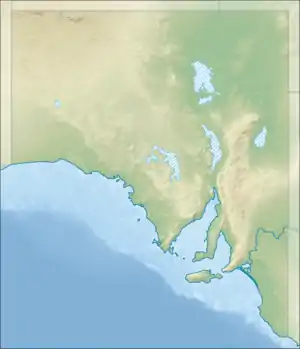Kaiserstuhl Conservation Park
The Kaiserstuhl Conservation Park is a protected area located in the Australian state of South Australia in the suburb of Flaxman Valley about 80 kilometres (50 mi) north-east of the state capital of Adelaide and about 12 kilometres (7.5 mi) south-east of the town of Tanunda.[2][3]
| Kaiserstuhl Conservation Park South Australia | |
|---|---|
 The Kaiserstuhl | |
 Kaiserstuhl Conservation Park | |
| Nearest town or city | Tanunda[2][3] |
| Coordinates | 34°35′04″S 139°00′48″E[1] |
| Established | 3 May 1979[4] |
| Area | 4.35 km2 (1.7 sq mi)[5] |
| Visitation | 5,000 to 10,000. (in 2006)[3] |
| Managing authorities | Department for Environment and Water |
| Website | Kaiserstuhl Conservation Park |
| See also | Protected areas of South Australia |
The conservation park consists of land in sections 531, 623, 730, 732, 733, 736, 737, 844, 859, 860, 861 and 862 in the cadastral unit of the Hundred of Moorooroo and which is an area bounded in the east by a sealed road, Tanunda Creek Road.[2][4][6] The Heysen Trail, the long distance walking trail, passes along the west side of the conservation park.[7][2]
It was proclaimed under the National Parks and Wildlife Act 1972 on 3 May 1979 for the above-mentioned parcels of land with exception to sections 859, 860, 861 and 862 which were added by proclamation on 3 December 1987. It is named after a hill called Kaiserstuhl which is located to its immediate west in the suburb of Pewsey Vale.[2][3][4][6] As of 2016, it covered an area of 4.35 square kilometres (1.68 sq mi).[5]
The conservation park is classified as an IUCN Category III protected area.[1] In 1980, it was listed on the now-defunct Register of the National Estate.[8]
Kaiserstuhl/Patpoori
Kaiserstuhl (literally "emperor's chair") is a mountain of about 600 metres (2,000 ft) height located in a northern part of the Mount Crawford Forest (Kaiserstuhl Native Forest Reserve) in the locality of Pewsey Vale. It was named by geologist Joseph Menge after the Kaiserstuhl mountain range near Freiburg in southwestern Germany, a famous winegrowing region. It is dual-named with the Aboriginal name Patpoori. The German name was changed to Mount Kitchener in 1918, but has since been changed back.[9]
References
- "Terrestrial Protected Areas of South Australia (refer 'DETAIL' tab )". CAPAD 2016. Australian Government, Department of the Environment (DoE). 2016. Retrieved 21 February 2018.
- "Search results for 'Kaiserstuhl Conservation Park' with the following datasets selected – 'Suburbs and Localities', 'NPW and Conservation Properties', 'Gazetteer', 'Roads' and 'Recreation Trails'". Location SA Map Viewer. Government of South Australian Government. Retrieved 9 May 2018.
- Management plan : Kaiserstuhl Conservation Park (PDF), Department for Environment and Heritage, South Australia, 2006, pp. 1, 3 & 21, ISBN 978-1-921018-88-6
- Cornwall, J.R. (3 May 1979). "NATIONAL PARKS AND WILDLIFE ACT, 1972-1978: HUNDRED OF MOOROOROO—CONSERVATION PARK CONSTITUTED" (PDF). The South Australian Government Gazette. South Australian Government. p. 1313. Retrieved 9 May 2018.
- "Protected Areas Information System Reserve List" (PDF). Government of South Australia. 9 March 2018. Retrieved 26 April 2018.
- Abbott, R.K. (3 December 1987). "NATIONAL PARKS AND WILDLIFE ACT, 1972, SECTION 30: KAISERSTUHL CONSERVATION PARK—ALTERATION OF BOUNDARIES" (PDF). The South Australian Government Gazette. South Australian Government. p. 1732. Retrieved 10 May 2018.
- "Section 18: Pewsey Vale to Tanunda". The Heysen Trail. The Friends of the Heysen Trail and Other Walking Trails Inc. Retrieved 10 May 2018.
- "Kaiser Stuhl Conservation Park – listing on the now-defunct Register of the National Estate (Place ID 7018)". Australian Heritage Database. Australian Government. 21 October 1980. Retrieved 9 May 2018.
- "Placename Details: Kaiserstuhl". Property Location Browser. Department of Planning, Transport and Infrastructure, Government of South Australia. SA0033466. Retrieved 27 November 2014.
Joseph Menge, a German geologist, named the hill after a hill near Bismarck on the Rhine. [...] Dual named with the Aboriginal name Patpoori.